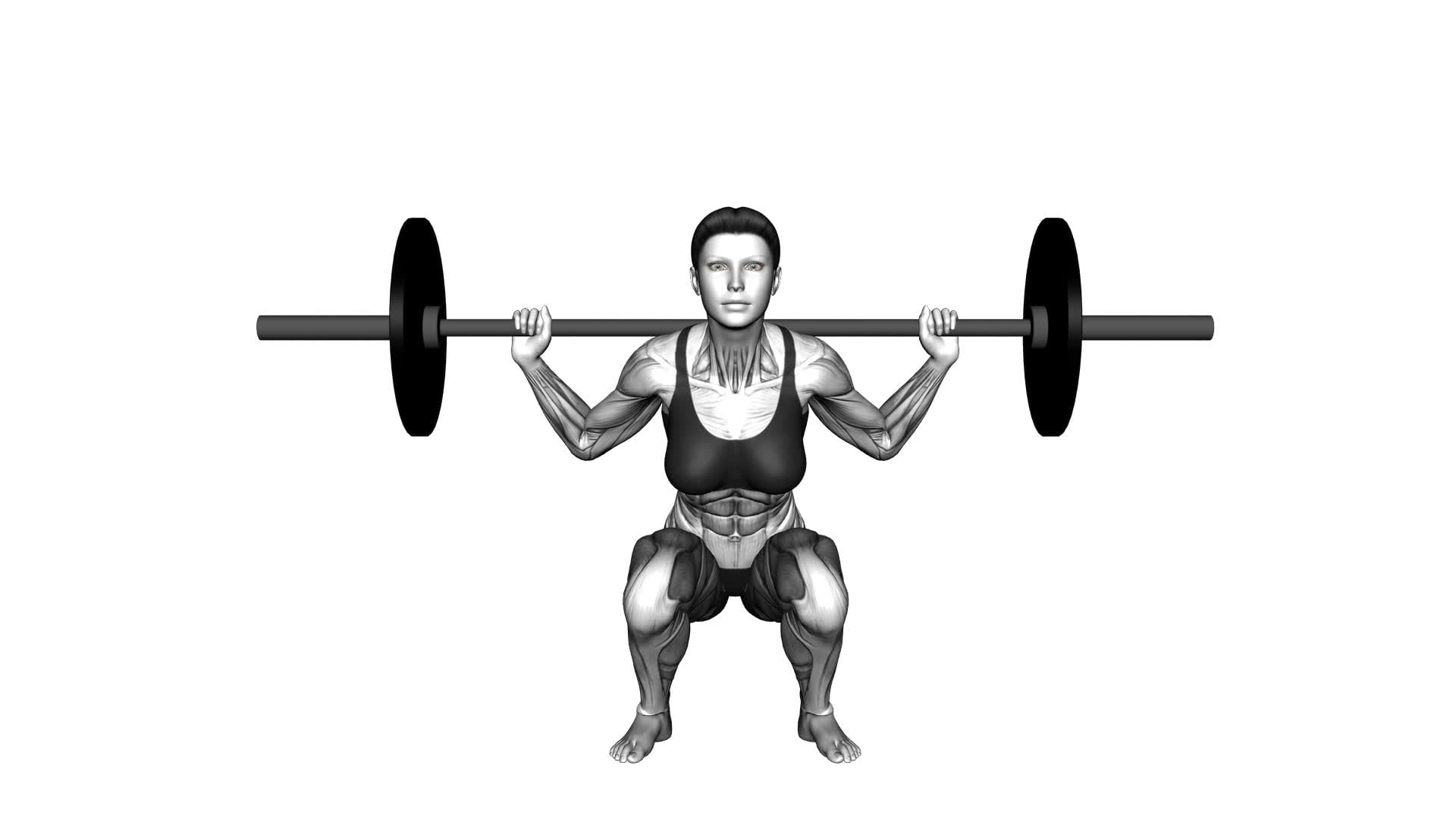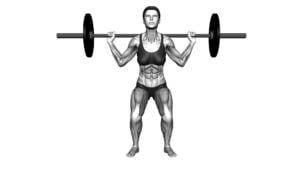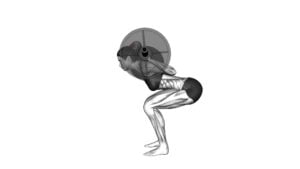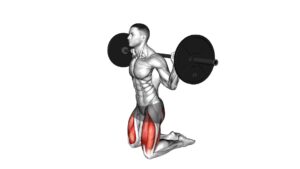Barbell Squat – Knees – End Position (Wrong Right) (Female) – Video Exercise Guide & Tips

Are you struggling to find the right end position for your barbell squat?
Watch This Exercise Video
In this video exercise guide, we will show you the common mistakes to avoid and provide tips for achieving the correct positioning of your knees.
By properly executing the barbell squat, you can reap the benefits of increased strength and stability.
So, let's get started and make sure you nail that end position for maximum results!
Key Takeaways
- Proper knee alignment is crucial for preventing common knee injuries during barbell squats.
- Misalignment puts excessive stress on the knee joint, increasing the risk of injury.
- Maintaining proper form and technique is essential to avoid common mistakes such as knees collapsing inward or locking out at the top of the squat.
- Achieving the right end position requires attention to detail and proper technique, which can lead to improved strength, stability, and overall lower body development.
Importance of Proper Knee Alignment
You should understand the importance of proper knee alignment while performing barbell squats. Proper knee alignment is crucial to prevent common knee injuries and ensure effective muscle engagement during this exercise. When your knees aren't aligned correctly, it puts excessive stress on the joint and surrounding structures, increasing the risk of injury.
One common knee injury that can occur due to improper alignment is patellofemoral pain syndrome, also known as runner's knee. This condition causes pain around the kneecap and can be debilitating if not properly addressed. Another injury that can result from poor knee alignment is an anterior cruciate ligament (ACL) tear. This is a serious injury that often requires surgery and extensive rehabilitation to recover fully.
To prevent these injuries and maintain proper knee alignment, it's essential to perform knee rehabilitation exercises regularly. Strengthening the muscles that support the knee, such as the quadriceps and hamstrings, can help stabilize the joint and prevent misalignment. Exercises like leg extensions, hamstring curls, and lunges are beneficial for strengthening these muscles.
Common Mistakes to Avoid
To avoid common mistakes while performing barbell squats, it's important to focus on proper form and technique. One of the most common mistakes people make is improper knee alignment. When performing a squat, it's crucial to ensure that your knees are properly aligned with your toes. Many people tend to let their knees collapse inward, which can put unnecessary stress on the knee joint and increase the risk of injury. To avoid this mistake, make sure to keep your knees in line with your toes throughout the entire movement.
Another common mistake is locking out your knees at the top of the squat. This can lead to hyperextension and strain on the knee joint. Instead, focus on maintaining a slight bend in your knees at the top of the movement to prevent any excessive stress on the joint.
Lastly, avoid leaning too far forward or backward during the squat. This can cause improper weight distribution and put excessive strain on the knees. Remember to keep your torso upright and maintain a balanced position throughout the exercise.
Correct Positioning of the Knees
Proper alignment of the knees is essential when performing a barbell squat. The importance of knee stability can't be overstated, as improper form can lead to injury and long-term damage. To ensure the safety of your knees, it's crucial to maintain proper form throughout the exercise.
When performing a barbell squat, start by standing with your feet shoulder-width apart and toes slightly turned out. As you begin the squat, push your hips back and lower your body by bending your knees. It's important to keep your knees in line with your toes throughout the movement. Avoid allowing your knees to collapse inward or extend too far forward, as this puts unnecessary strain on the joint.
To maintain proper form for knee safety, focus on keeping your weight in your heels. This will help to engage your glutes and hamstrings, taking some of the pressure off your knees. Additionally, make sure to keep your chest lifted and your core engaged throughout the squat. This will help to stabilize your body and prevent any excessive forward leaning or rounding of the back.
Tips for Achieving the Right End Position
Maintain the correct alignment of your knees throughout the barbell squat to ensure a safe and effective end position. Achieving the right end position requires proper technique and attention to detail. Here are some tips to help you achieve balance and proper weight distribution:
- Focus on your stance: Start with your feet shoulder-width apart and toes pointed slightly outward. This will help you maintain stability throughout the movement.
- Engage your core: Keeping your core muscles activated will help you maintain balance and stability as you squat down and come back up.
- Distribute the weight evenly: Make sure to distribute the weight evenly between your heels and the balls of your feet. Avoid shifting too much weight onto your toes, as this can put excessive strain on your knees.
- Keep your knees in line with your toes: As you lower into the squat, ensure that your knees track in line with your toes. Avoid letting them collapse inward or push too far forward, as this can increase the risk of injury.
Benefits of Properly Executing the Barbell Squat
Achieving proper technique in the barbell squat offers numerous benefits, including improved strength, stability, and overall lower body development. When executed correctly, the barbell squat activates multiple muscle groups simultaneously, making it an efficient exercise for building strength and muscle mass.
The quadriceps, hamstrings, glutes, and calves are all major muscle groups that are targeted during the squat. By engaging these muscles, you can experience significant gains in lower body strength and power.
Proper execution of the barbell squat also helps to improve stability and balance. As you lower into the squat position, your core muscles, including the abdominals and lower back, work to stabilize your spine. This not only strengthens your core, but also enhances your overall stability and balance, which can be beneficial in various athletic activities and everyday movements.
In addition to strength and stability, properly executing the barbell squat can help prevent injuries. By strengthening the muscles surrounding the knees, such as the quadriceps and hamstrings, you can reduce the risk of knee injuries, such as sprains and strains. The squat also promotes improved joint mobility and flexibility, which can further protect against injuries during physical activities.
Frequently Asked Questions
What Are Some Common Mistakes to Avoid When Performing the Barbell Squat?
When performing the barbell squat, it's important to avoid common mistakes that can prevent you from achieving the correct end position.
One mistake to avoid is letting your knees cave inwards, which puts unnecessary strain on your joints.
Another mistake isn't going low enough, as this limits the effectiveness of the exercise.
Make sure to maintain proper form and engage your core throughout the movement to maximize results and minimize the risk of injury.
How Can I Achieve the Correct End Position in the Barbell Squat?
To achieve the correct end position in the barbell squat, focus on improving your form. Keep your knees aligned with your toes, ensuring they don't cave inward or extend too far forward.
Maintain a neutral spine and engage your core throughout the movement. Control the descent and ascent of the squat, avoiding any sudden or jerky movements.
Gradually increase the weight as you become more comfortable with proper barbell squat form.
What Are the Benefits of Properly Executing the Barbell Squat?
Properly executing the barbell squat offers numerous benefits. By using the correct form and technique, you can strengthen your legs, glutes, and core muscles. This exercise also improves your overall stability and balance.
Additionally, the barbell squat can increase your bone density and promote better posture. It's crucial to focus on proper execution to maximize these benefits and minimize the risk of injury.
What Are Some Tips for Maintaining Proper Knee Alignment During the Barbell Squat?
To maintain proper knee alignment during the barbell squat, there are a few things to keep in mind.
One common mistake is allowing your knees to cave inward or move too far forward. To prevent this, focus on pushing your knees out and keeping them in line with your toes throughout the movement.
Additionally, cues like 'hips back, chest up' can help you maintain the correct positioning and avoid unnecessary stress on your knees.
Are There Any Specific Cues or Techniques to Help With Correct Knee Positioning in the Barbell Squat?
To maintain proper knee alignment during the barbell squat, there are specific cues and techniques you can use.
One cue is to focus on pushing your knees outwards as you squat down. This helps to engage the glutes and keeps your knees tracking in line with your toes.
Another technique is to make sure your weight is evenly distributed between your heels and the balls of your feet. This will help to prevent any excessive forward or backward movement of the knees.
Conclusion
In conclusion, proper knee alignment is crucial when performing barbell squats. Avoiding common mistakes and positioning the knees correctly won't only help prevent injuries but also ensure effective execution of the exercise.
By following the tips provided and achieving the right end position, individuals can reap the benefits of a properly executed barbell squat, such as improved strength, muscle development, and overall fitness.

Author
Years ago, the spark of my life’s passion ignited in my mind the moment I stepped into the local gym for the first time. The inaugural bead of perspiration, the initial endeavor, the very first surge of endorphins, and a sense of pride that washed over me post-workout marked the beginning of my deep-seated interest in strength sports, fitness, and sports nutrition. This very curiosity blossomed rapidly into a profound fascination, propelling me to earn a Master’s degree in Physical Education from the Academy of Physical Education in Krakow, followed by a Sports Manager diploma from the Jagiellonian University. My journey of growth led me to gain more specialized qualifications, such as being a certified personal trainer with a focus on sports dietetics, a lifeguard, and an instructor for wellness and corrective gymnastics. Theoretical knowledge paired seamlessly with practical experience, reinforcing my belief that the transformation of individuals under my guidance was also a reflection of my personal growth. This belief holds true even today. Each day, I strive to push the boundaries and explore new realms. These realms gently elevate me to greater heights. The unique combination of passion for my field and the continuous quest for growth fuels my drive to break new ground.







